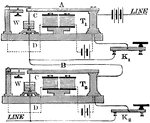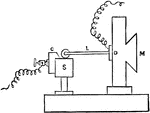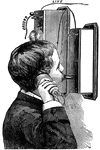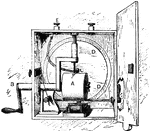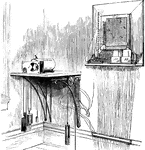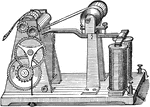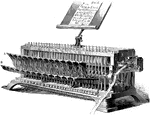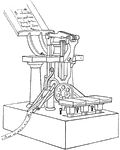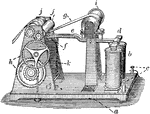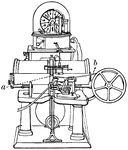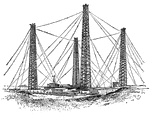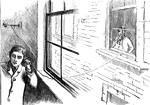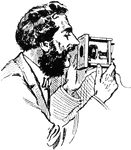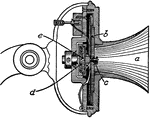The Telephone and Telegraph Industry ClipArt gallery offers 75 illustrations of telephones and telegraph equipment, including early models and supporting infrastructure such as cable and switchboards.
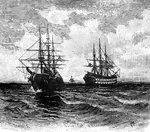
Atlantic Cable
"Laying the Atlantic Cable. In 1866, a previous attempt in 1858 having failed, a telegraphic cable was…

The Original Atlantic Cable
"The illustration shows seven copper wires (4) forming a conductor; a wrapping of thread (3) soaked…
Telegraph Cable
Telegraph cable laid at the bottom of the ocean or through festoons, allowing for gradual setting.
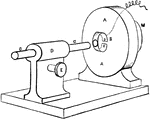
Carbon Telephone
Edison's Carbon Telephone. He tried using carbon with the purpose of reducing the delicacy of the instrument.
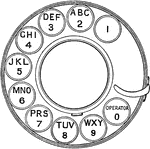
Telephone Rotary Dial
An illustration of the rotary dial on phones. Each hole corresponds to the number shown. To dial the…

Magnetic Telegraph
"Morse magnetic telegraph will be understood by reference to the accompanying diagram, which represents…

Morse Apparatus, Circuit and Battery
Samuel F. B. Morse independently developed an electrical telegraph in 1837, an alternative design that…
Morse Key
Telegraph key, also known as a Morse key, are generic terms for any switching device used primarily…
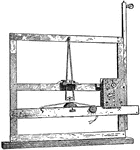
Morse's First Telegraph Instrument
A form of long-distance communication, which used electricity to send and receive messages.

Samuel Morse
Samuel Morse explaining his telegraph to members of Congress. Morse made his last trip to Washington,…

Morses Telegraph
"The machine itself is sufficiently simple, and will be comprehended at once, by those who have made…
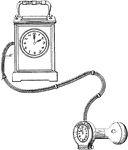
Pay Phone
A pay phone or pay phone is a public telephone, with payment by inserting money (usually coins) or a…
Wireless Telegraph Receiver
"Wireless Telegraphy is a system of transmitting messages between distant points without the use of…

Railway Signal
A signal is a mechanical or electrical device erected beside a railway line to pass information relating…
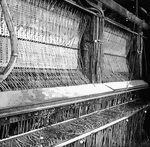
Switchboard
"Under side of a modern switchboard, showing 2,000 telegraph wires."—E. Benjamin Andrews 1895

Telegraph
An instrument to send messages by means of electricity, either at short or long distances. An instrument…

Telegraph Instrument
"The first telegraphic instrument, as exhibited in 1837 by Morse."—E. Benjamin Andrews 1895
Telegraph Key
Telegraph key is a general term for any switching device used primarily to send Morse code. Similar…
!["The sounder is a telegraphic receiver consisting of an electromagnet, and a pivoted armature that plays up and down between its stops as the circuit is alternately made and broken. the message is 'read by sound,' i.e., from the clicks made by the armature, substantially as indicated [before]." -Avery 1895](https://etc.usf.edu/clipart/36000/36092/tele_sound_36092_mth.gif)
Telegraph Sounder
"The sounder is a telegraphic receiver consisting of an electromagnet, and a pivoted armature that plays…

Telegraph Transmitter
"A transmitter or key is a current interrupter manipulated by the operator. It consists essentially…

Disc Telegraph
A telegraph in which the letters of the alphabet or figures are placed on a circular plate in such a…
Telegraph Using Galvanoscopes
"Instead of the telephone receivers normally used in telegraphs, substitute with galvanoscopes. When…
One Way Telegraph
"A long ribbon of white paper is attached on a spool, and connected to a receiver that is wired to a…
!["The Morse register is represented [here]. The armature, A , is supported at the end of a lever, and over the cores of the magnet bobbins, M. A spring, S, lifts the armature when the cores are demagnetized on the breaking of the circuit by the operator at the key. When A is pulled down by M, a style or pencil at P is pressed against R, a paper ribbon that is drawn along by clock work. this style may be made to record upon the paper a dot-and-dash communication sent by the operator at a key, perhaps hundreds of miles away." -Avery 1895](https://etc.usf.edu/clipart/36000/36091/morse_reg_36091_mth.gif)
Morse Telegraph Register
"The Morse register is represented [here]. The armature, A , is supported at the end of a lever, and…

Telegraph Relay
"With a long main-line and many instruments in circuit, the resistance may be so great as to render…
Cable System Telegraph Repeater
A cable system telegraph repeater device. The telegraph repeater device is used to send and receive…

Simple Telegraph
"The electric telegraph in its simplest form, consists of an electric circuit connecting he points between…
Simple Telegraph
"A simple telegraph consisting of two telephone receivers, two batteries, and two keys." -Avery 1895

Telegraph Sounder
"A variation of the telegraph sounder that uses a pool of mercury to close the circuit to produce the…
Complete Telegraph System
"A complete telegraph system, displaying batteries, keys, receivers, relays and local batteries on both…
!["...two stations...each being furnished with a neutral relay, connected as [shown] and also each with a sounder and key, at each of which an operator is seated..." -Atkinson 1903](https://etc.usf.edu/clipart/35700/35744/neutral_35744_mth.gif)
Telegraph with Neutral Relay
"...two stations...each being furnished with a neutral relay, connected as [shown] and also each with…

The Inner Workings of Telegraphy
Telegraphy is the long distance transmission of written messages without physical transport of letters.…

Telephone
An instrument for reproducing sound at a distance by the transmission of impulses through the agency…
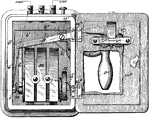
Placing a Phone Call
A typical phone call, traditionally, is placed by picking the phone handset up off the base and holding…
